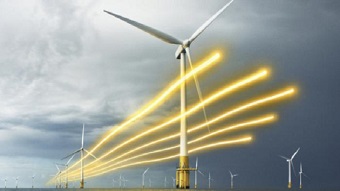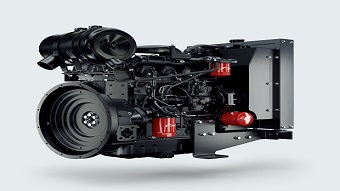Cooling Water Corrosion and Its Control:Part 1
Brad Buecker, Process Specialist, Kiewit Engineering and Design Co. | January 23, 2017Engineering360 already has examined in a three-part series fundamental corrosion mechanisms and their control in steam generating systems. What may appear at first to be a mild problem can have severe consequences that incur huge costs and, more importantly, jeopardize employee safety.
But steam generation represents only one portion of what are usually a number of water-supplied heat transfer systems at power and industrial plants. With this next series of articles, we will examine cooling water corrosion issues and explore how aspects of the cooling water environment can radically influence the selection and performance of the materials chosen for heat exchanger tubes and other equipment.
Cooling System Issues
The author began his career at a power plant with once-through cooling for turbine exhaust steam cooling and for other major auxiliary heat exchangers. Once-through cooling was a common choice for many plants in the last century, although cooling towers were certainly also very much a part of many designs.
Once-through cooling has become less common, as regulations have been enacted to protect aquatic creatures from impingement/entrainment and thermal hazards at plant intakes and discharges, respectively. Thus, cooling towers (or in an increasing number of cases air-cooled heat exchangers) increasingly are de rigueur at new facilities.
With once-through cooling, but perhaps even more pronounced with cooling tower-based systems, many possibilities exist for fouling and corrosion of cooling system equipment. Some of the most important include:
- Potential formation of microbiological deposits that not only restrict heat transfer but can cause a variety of under-deposit corrosion mechanisms, which we will explore in more detail.
- Increased potential for scale formation due to “cycling up” of impurities in the cooling tower combined with increased temperature in the heat exchangers.
- The potential for direct corrosion from impurities such as chloride, which also will cycle up in the cooling tower or if introduced from brackish water makeup. Seawater, of course, is the ultimate chloride source. Note that at an increasing number of plants, sources such as municipal wastewater treatment plant effluent are being chosen or mandated for makeup. If untreated, these supplies introduce additional impurities including ammonia, phosphorus, and organic compounds to the cooling system.
These variables can affect heat exchanger materials selection, so we will first examine two of the most popular materials selected for many heat exchanger tubes, 304 and 316 stainless steel. We will also consider how the properties of these basic stainless steels increase their susceptibility to severe corrosion in particular situations.
Table 1 – Percentage Concentration Ranges of Elements (Iron Balance) in 304 and 316 Regular and Low Carbon Stainless Steels (Adapted from Ref. 1)
|
Matl. |
Cr |
Ni |
Mo |
Mn |
Si |
C |
P |
S |
Low C |
| 304 SS | 18-20 | 8-11 | 2.00 | 1.00 | 0.08 | 0.045 | 0.030 | 0.03 | |
| 316 SS | 16-18 | 10-14 | 2-3 | 2.00 | 1.00 | 0.08 | 0.045 | 0.030 | 0.03 |
For steel to be “stainless” it must have a chromium content of 12% or greater. At these concentrations, the chromium causes the steel to form a protective oxide layer that under many conditions is tenacious.
When the oxide layer is complete with no disruptions, the steel is in what is termed a “passive” state and is protected. If, however, the oxide layer is damaged, the disrupted sites will become anodic [Ref. 2] in an environment that is typically still very much cathodic. Rapid attack can occur at the anodes, and cases are known of through-wall penetrations within months and even weeks.
So, what constitutes these corrosion mechanisms? Consider first a general process that can occur due to deposition.
Stainless steels in a clean environment maintain their passive layer by continual introduction of oxygen to the surface. If deposition occurs, the locations underneath deposits become oxygen starved and set up what are known as oxygen differential cells. These locations become anodic to surrounding bare metal, and pitting corrosion is a likely result. This attack can be much more severe underneath microbiological deposits rather than hard scale because microbiological colonies are fluid and allow the iron cations formed at the corrosion site to be transported away from the active site, thus perpetuating the mechanism.
Apart from this issue, microbiological colonies can be problematic with regard to two other corrosion mechanisms. The colonies are typically complex, with numerous bacteria species thriving within the colony. Some are aerobic, meaning that they need oxygen to survive and grow, but many are anaerobic and use other compounds for energy.
One of the most notorious of this group is sulfate reducing bacteria, which extract oxygen from the sulfate ion (SO4-2). A byproduct of this metabolism is the sulfide ion (S-2), an anion that will react with many metals, including iron and copper. (In reference 3 the authors outline failure of copper-nickel condenser tubes in just 18 months due to sulfide corrosion, where the sulfide was introduced from a tube milling lubricant.) Other acids may also form underneath deposits, and these compounds can also directly attack the metal.
Yet another problem that can occur at deposit/tube metal boundaries, or at other locations in the heat exchanger such as the joints between tubes and tube sheets, is crevice corrosion. These spots behave similarly to oxygen depletion cells in that the environment within the narrow crevice may become oxygen starved, and then can become anodic to the surrounding surface.
Impurities in the water, and particularly chlorides, will concentrate within the crevices and drive the corrosion mechanism. Increased recognition of the difficulties caused by crevice corrosion has influenced water treatment chemistry and materials selection guidelines in recent years, as we shall explore below and in future articles.
Water Impurity and Stainless Steel Corrosion
As is commonly known, the majority of heat exchange in a cooling tower is due to evaporation of a small percentage of the incoming circulating water. Even though this percentage (typically 2-3%) is small, the continuous evaporation causes the impurities in the circulating water to increase in concentration.
A common cycles-of-concentration (COC) range for cooling towers is 4 to 8, although in arid locations an even higher COC may be selected to conserve water. Of course, as COC increases so does the potential for scale formation and corrosion. Most notoriously with regard to the latter is chloride corrosion.
As we have seen, stainless steels depend upon an oxide layer for protection. Chloride in particular will penetrate this layer and induce pitting corrosion. It is now known that as little as 200 parts-per-million (ppm) chloride may induce crevice corrosion in 304 SS, with 316 SS being somewhat better, with a recommended limit of perhaps 400 to 500 ppm chloride. (In large measure, the increased corrosion resistance of 316 SS is due to the addition of molybdenum.)
Contrast this to recent projects that the author has worked on, where incoming makeup water chloride concentrations were in the 100 to 300 ppm range. Even at a relatively low COC of 4 in the cooling tower, the recirculating chloride concentration corresponds to a range of 400 to 1,200 ppm, which can be problematic for 304 or 316 stainless steel.
Compounding the problem is that unlike many other impurities in the makeup water, which can be precipitated or otherwise removed in a pretreatment process, chloride is soluble and can only be removed by expensive methods such as reverse osmosis. Typically, the better choice when chloride is of concern, as will be outlined in Part 2 of this series, is upgraded material selection for heat exchanger tubes.
Now consider that personnel at new plants, and even at some existing plants, must select or switch to alternative sources to fresh water for plant makeup. A common emerging source is effluent from publicly owned treatment works (POTW), better known as wastewater treatment plants.
In addition to the normal impurities found in other water supplies, these streams also typically contain elevated concentrations of ammonia, phosphorus, and organic compounds. Ammonia will induce direct corrosion of copper alloys, although these alloys have become much more rare for power plant heat exchanger tubing applications.
More important is that ammonia/phosphorus and organics, respectively, serve as nutrients and food for microorganisms. The author will expand upon this chemistry and its control in a future series of articles. In the meantime, expect to see a continued discussion of heat exchanger materials in Part 2 of this series.
References
1. D. Janikowski, “Factors for Selecting Reliable Heat Exchanger Tube Materials”’ 33rd Annual Electric Utility Chemistry Workshop, June 11-13, 2013, Champaign, Ill.
2. B. Buecker, “Engineer's Guide to Corrosion – Part 1”; IEEE Global Spec 360, October 2016.
3. Buecker, B. and E. Loper, “Selecting Condenser Replacement Tubes”; Power Engineering, Vol. 100, No. 3, March 1996.




